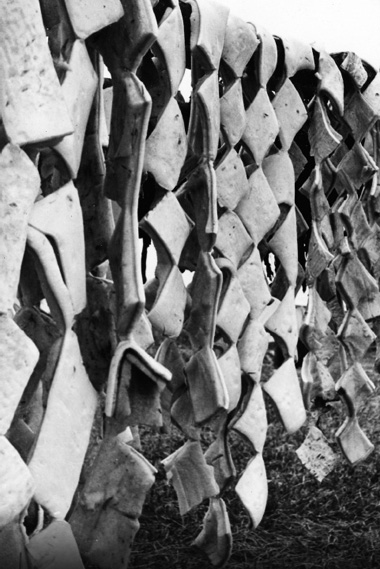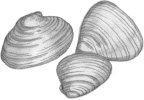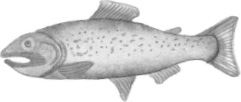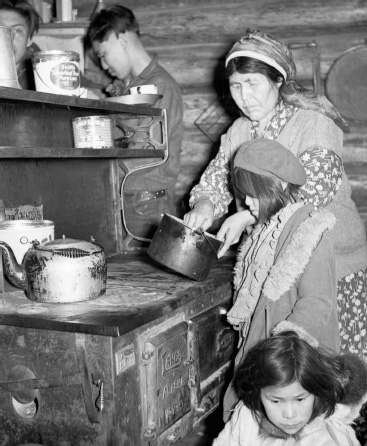
Beluga whale meat on drying racks, Kotzebue.

Beluga whale meat on drying racks, Kotzebue.
Cooking Alaskan  RECIPE BY HELEN HICKOX, former teacher, Gambell High School, Saint Lawrence Island
RECIPE BY HELEN HICKOX, former teacher, Gambell High School, Saint Lawrence Island
Muktuk is the blubber and skin of whale. The black, thin layer of skin on white, pinkish blubber is muktuk. It is eaten just as it comes off the whale. It is cut in small strips, sliced thin, and eaten with salt. Some people use seasoned salt as well. Some say it tastes like coconut, but to me it tastes a lot like salt pork before cooking.
The only part used is the skin that covers the blubber.
Today my recipe will be making half-dried boiled salmon,“ Uto told her friends. “After the salmon has dried for three days, take down enough for a meal, and cut it into three-inch pieces. Put the pieces in boiling water. Let the half-dried fish boil until the raw part of the fish is done. Serve it on your fish platter with a side dish of greens and seal oil. That is my recipe.”
—The Storytellers’ Club, LORETTA OUTWATER COX
Cooking Alaskan  RECIPE BY ELFIE APATIKI,
RECIPE BY ELFIE APATIKI,
Community Education Program Cookbook,
Gambell, Saint Lawrence Island
On Saint Lawrence Island, mukluk is giant or bearded seal. For the following recipe, the cook suggests rinsing the meat thoroughly and soaking it in salted water before it is ground. Use 2 tablespoons salt per gallon of water. Drain well, chop or grind the meat and proceed.
1 pound chopped or ground mukluk meat
1 egg or 3 tablespoons powdered egg
1 cup rolled oats
¼ cup flour
1 cup canned peas with juice
½ teaspoon salt
¼ teaspoon pepper
• Mix all ingredients thoroughly. Put in greased loaf pan. Bake for 20 to 30 minutes at 450°F. Walrus meat can be used in the recipe, but it requires longer baking, about 45 minutes.
To a devoted seafood fiend, the two-toned muktuk tasted like the smoothest sushi imaginable.
Munching off my sword-ke-bab and dripping whale oil, I examined the fully landed animal carefully, circling it. We had the relationship mixed up, it seemed to me for a second. This whale should be eating us.
Putting up [the whale meat] had just been the relatively easy first stage. Now we had to get the 46 tons into bite-sized, or at least boulder-sized packages. We were clearly into an all-night activity, at least. Which isn’t too bad, when you consider that it’s meat for four months, for everybody.
—Not Really an Alaskan Mountain Man, DOUG FINE
Cooking Alaskan 
Recipe adapted from Walrus in the Cooking Pot
Corned walrus—rated very good.
1 well-trimmed chunk of walrus meat, 6 to 8 pounds
1 gallon water to which ¼ cup vinegar is added
1 tablespoon garlic salt
1 tablespoon saltpeter
4 tablespoons plain salt
5 tablespoons allspice
5 tablespoons sugar
½ teaspoon cinnamon
• Soak the meat in vinegar-water for about 10 minutes. Then take it out and wipe it dry. Mix the remaining ingredients in a bowl. Cut several slits in the meat and put some of the spice mixture down into the cuts. Rub the rest over the outside of the meat. Wrap the meat securely in heavy plastic and store it in a cold place, below 45°F but above freezing, for four days.
• Then wrap in foil tight enough that meat juices will not escape during cooking. Roast in an uncovered pan in a slow oven, 300°F for about four hours.
• Let the meat cool before slicing into serving pieces.
Cooking Alaskan  RECIPE FROM HELEN FISHER
RECIPE FROM HELEN FISHER
An Alaskan Cook Book, Kenai
• Take one whale and clean well. Strip off all of the whale fat, and soak meat in vinegar for a few hours. The meat is fine-grained, dark red, and looks as if it should taste like beef. For a quick whale dish, slice meat into thin slices and brown in vegetable oil. Then pour prepared barbecue sauce or mushrooms over the browned meat and simmer until tender. Don’t cheat and use garlic—let the full rich whale flavor come through.
Cooking Alaskan 
RECIPE BY MARY DUNCAN, ANGOON
1 seal hindquarter
1 teaspoon salt
Mixed pickling spices
1 large onion
3 cups water
1¼ cups vinegar
¾ cup flour
1 teaspoon curry powder
1 teaspoon ground ginger
1 teaspoon garlic powder
• Place hindquarter in roasting pan and sprinkle with salt and pickling spices. Slice the onion in rings and scatter over the roast. Cover and put into the oven at 400°F for 2 hours or more, depending on the size. When the roast is almost done, mix the vinegar, water, flour, curry, ginger, and garlic powder like gravy and pour it into the meat juices in the roasting pan and stir well. Then cover roast again and cook for another 15 to 20 minutes. Serve with rice.
MAKES 6 SERVINGS.
Cooking Alaskan  RECIPE BY FELECTA TETPON
RECIPE BY FELECTA TETPON
Cut the seal fat in strips and put in a large container. Let it sit till it renders. When it renders, it starts to smell, but the smell is the natural smell of seal oil. The rendering place shouldn’t be too cold, but not too warm either. In Shaktoolik, it is cool enough so you don’t have to worry about the seal oil. In Homer, the weather is warmer and some of my seal oil has spoiled. Pour off the oil and store it before all of it is rendered. Remaining fat still renders.
Years ago, my mother put the fat in a seal poke [a container made from a seal stomach or a sealskin]. My husband [ivory carver Eric Tetpon] and I had to learn how to make our own seal oil. I didn’t watch how my mother did it enough. My parents told me to leave a hole in the seal poke so the air could come in and keep it fresh. Keep the seal poke in a cool place.
Cooking Alaskan 
KAA T’EIX (MARY HOWARD PELAYO),
Kaa T’eix’s Cook Book, Mount Edgecumbe
The rendered seal oil (page 120) has many uses. The older generation never went without seal oil for cooking. They used it to add flavor to the salmon, seaweed with salmon eggs, or diced clams, dried cockles, and sea ribbons. They even added the oil to desserts like mixed berries. It is especially used with dried fish. Dried fish is what you call a finger food nowadays. You take the roasted dried fish and hold it in your two fingers and dip it into seal oil. This is good eating.
It was probably because the Tlingits dried so many of their edible foods that they usually served seal oil with it. It was easier to eat the food that way and so much tastier.

This was Mark’s first bearded seal, proving him a marriageable man, able to hunt well and provide for a family. Before the seal party, all the blubber and meat had been sawed into big hunks. The seal oil had been rendered and poured into empty pancake syrup bottles and salad dressing jars. The guests had brought plastic pails and kiddie sleds to carry home the hunks and oil, and all the other gifts.
—Place of the Pretend People, CAROLYN KREMERS
Cooking Alaskan 
Recipe from The Hunter Returns After the Kill
Jellied moose nose is a sourdough specialty known and enjoyed only in moose country. It is not easy to prepare, but, like head cheese, is a worthwhile delicacy.
• Cut the upper jawbone of the moose just below the eyes. Put it in a large kettle of scalding water and boil it for 45 minutes. Remove it and plunge it into cold water to cool. Pick the hairs from the nose as you would feathers from a duck (the boiling loosens them), and wash the nose thoroughly.
• Put the nose in a kettle and cover it with fresh water. Add a sliced onion, a little garlic, and pickling spices and boil it gently until the meat is tender. Let it cool overnight in cooking liquid.
• In the morning, take the meat out of the broth and remove the bones and cartilage. You will have two kinds of meat: the bulb of the nose is white and the thin strips along the bone and jowls are dark. Slice the meat thinly, pack it into a high-sided glass dish, and cover it with juice. You may add salt, pepper, or other spices to the juice if they are needed. Some people add vinegar to suit their own taste. Refrigerate. The mixture will jell, and when it is firm, can be sliced for cold serving.
Cooking Alaskan 
From “Early Day Recipes,” Tsimpshean Indian Island Cookbook, Metlakatla
• Shell and clean gooey duck thoroughly. Cut off neck. Pour boiling water over and scrape the skin. Slit one side of the neck to open flat. Slice main part of gooey duck in half. Dip gooey duck into beaten eggs with grated onion. Then dip into corn meal. Fry for three minutes on each side.
Cooking Alaskan  RECIPE BY JOE RYCHETNIK,
RECIPE BY JOE RYCHETNIK,
“Dining Along the Eskimo Coast,” Alaska Sportsman magazine, April 1964
Use either spruce hen or ptarmigan and allow 1 per person.
Rice
2 tablespoons butter
1 clove garlic, crushed
1 cup raw rice
2 cups chicken broth or bouillon
½ teaspoon saffron
2 teaspoons salt
1 jar mushroom buttons with juice
1 package frozen carrots and peas
1 tablespoon monosodium glutamate
Bird(s)
Spruce hen or ptarmigan
• Skin and quarter the birds, shake the pieces in seasoned flour, and fry in bacon fat or other shortening until tender. Arrange meat around the rice on a serving platter.
• To cook the rice, heat butter in heavy skillet, add garlic and rice and cook, stirring constantly, until rice turns golden. Add hot chicken broth or bouillon and remaining ingredients and heat to boiling again, stirring occasionally to separate frozen vegetables. Cover, reduce heat, and cook until rice is tender and all liquid is absorbed, about 20 minutes.
MAKES 4 SERVINGS.
Starving is very painful, suffering, and sad, which makes you feel real sick,” Martha told the student. “That is, the stomach’s shrinking is very painful. Even if a person is a great hunter, if food is not available, the great hunter would starve. When animals and other living creatures were real hard to find, the two great hunters looked for other pieces that were left. When they found a small needlefish, they cut the needlefish in half and shared the needlefish. That was to fill their stomach!’
Among Yup’iks, sharing wasn’t a function of plenty, it was a function of survival. It was essential in the Arctic, and besides, sharing made people feel good.
—Place of the Pretend People, CAROLYN KREMERS
Cooking Alaskan 
Recipe from Tsimpshean Indian Island Cookbook, Metlakatla
Cut salmon into 1-inch pieces. Place alternately on a stick: salmon, pepper, onion. Place stick in a shallow dish. Pour oil and seasoning over and let stand for 1 hour. Drain and put fish over hot coals for 4 to 6 minutes. Keep stick turning. Can tell when done; the fish will flake.
2 pounds salmon steaks
1 green pepper, cut into 1-inch squares
10 small onions
1 cup oil
½ teaspoon oregano
½ teaspoon salt
½ teaspoon thyme
1 teaspoon pepper
½ teaspoon garlic powder

She thought about the commandment, “Thou shalt not steal.” When she was little, she remembered her mother, Ekiyuq, talking with her about this. One fall, while they gathered food for the winter, they were out looking for a storehouse of the field mice. When they found one, they knew it would be full of musu, or wild potatoes, all bite-size and sweet. The mice knew when the musu had the best taste, and dug them up to store them for the winter. Her mother wouldn’t take the whole store of wild potatoes from the mice, but left some, and even added some dried meat or fish in the place of the potatoes she took.
—The Storytellers’ Club, LORETTA OUTWATER COX
Cooking Alaskan  RECIPE BY J. T. BROWN,
RECIPE BY J. T. BROWN,
Port Edward, British Columbia,
“The Cabin Friend,” ALASKA magazine, May 1976
A method of cooking that has long been used by Pacific Northwest Coast Indians.
• Any fish can be planked. A plank or shake board can easily be made with an ax from materials at hand, including your camp-fire wood supply. Almost any type of nonresinous wood can be used; avoid cedar because of the heavy scent it gives off when heated. Bark can also be used. Length and width of the plank is governed by size of the fish to be cooked. Sharpen one end of the plank for forcing it into the ground.
• Scrape the scales off fish and cut out gills. Leave head, fins, and tail on. Slit the belly from vent to head. Remove viscera and scrape kidney tissue from backbone. Split the back from the inside so the fish can be opened wide as a book. Wash and pat dry. Wrap fish line around the fish and plank to hold fish in place while cooking; have wedges handy for slipping under the line to keep the fish tight and in place as it begins to shrink somewhat during cooking. Putting the planked fish in campfire smoke for a time before cooking improves the flavor—but keep it away from the heat.
• Salt and pepper the prepared fish, tuck some thin pieces of bacon or pork under the line at the top of the fish for basting. Onion rings add flavor, too. Force the pointed plank into the ground before a bed of hot coals, but not too close, or fish will scorch. Catch drippings in a spoon and baste if you wish. Meat is done when the flesh starts to curl and separate. Eat right off the plank.
Cooking Alaskan 
Recipe from The Alaska Dietary Survey
Boiled fresh fish heads, especially those of the salmon and white-fish, are highly prized among Northern Eskimos. The cheeks and fat behind the eyes and the soft chewy cartilage are particularly well liked for their very delicate flavor. Occasionally, when cooking fresh salmon heads, some of the fresh salmon roe may be added.

SARAH JOHN COOKING FOR POTLATCH, VENETIE.
Cooking Alaskan  RECIPE BY DICK PERSON,
RECIPE BY DICK PERSON,
Carcross, Yukon Territory
A recipe as generous as the size of your hand.
3 handfuls whole wheat flour
1 handful wheat germ
½ handful of bran
½ to ¾ handful corn meal
¼ to ½ handful rolled oats (Easy now. Too much will hold moisture and make the bannock soggy.)
Baking powder, approximately 1 teaspoon per cup of the above ingredients
2 to 3 tablespoons milk powder
1 egg
Water
Nuts, raisins, dates (and so on) to taste
Oil or shortening
• Mix the first five ingredients in a medium bowl, using portions to suit your taste. Estimate the number of “cups” in the bowl and add baking powder accordingly. Mix well. Add milk powder and egg and mix again. Add enough water to produce a batter that is slightly wet, sticky, and light. It should fall slowly from spoon in a sticky mass. Then add nuts, raisins, and other goodies as desired.
• Put enough oil in the fry pan to completely cover the bottom. (Bear fat is the very best shortening to use. Corn oil is also good. Soya oil is bad.) Heat oil until a tiny amount of water dropped on the pan spatters and crackles.
• Pour batter in fry pan and fry until done. All the bannock mixture should be used at one frying or the baking powder gases will quickly escape and the remaining batter will lie lifeless in the pan.
In the spring, the village became a festival of picking all kinds of greens, from sera, or willow, to ikuusuk, or wild celery; from fireweed, or kuppikutak, to wild rhubarb, or kunulik; from sourdock or kuagak, to Hudson’s Bay tea (also called Labrador tea), or tilaakik; and so on. Once they brought the greens home, it was important to allow the leaves to rest and cool before they preserved them in fresh seal oil from the spring hunt. Sikki thought, it’s like allowing the greens to have a grieving time before their spirits succumb.
—The Storytellers’ Club, LORETTA OUTWATER COX
Cooking Alaskan 
ALICE SMITH, MEKORYUK, Tundra Dreams
If you use fresh seal oil you don’t get the strong taste.
1 cup beef, caribou, or moose fat
½ to 1 cup seal oil (sometimes oogruk [bearded seal] oil)
½ cup, more or less, water or snow
10 to 12 cups cloud-berries
0 to 2 cups sugar
• Put a handful of Crisco in a bowl. Work it with your hand and add a little cold water. Put in the seal oil and work it more. The real Eskimo way was to make it with reindeer fat, chopped into small pieces. They put it on the stove to melt it. They never used to put sugar in. They used no sugar, just berries. Then later we used to put sugar in. Stir in the sugar. If you keep your hand working it a long time all the sugar melts, it dissolves. It will just fluffy up, now watch. You keep adding water, more water. Every time you put sugar in, it will fluff more. Keep working it and you can’t smell the seal oil. Then put in the salmonberries. There should be blackberries, too. And then I put it up in my little freezer up there, let it cool off, and eat it. If you just want to have a little spoonful now, you may.
They also gathered . . . a certain willow that they would need for medicinal purposes. Qutuuq used it for pain when she had her menstrual period or when someone was getting a bad cold. It also helped relieve headaches and fevers. Qutuuq also collected some stinkweed. She picked about four bundles, tied their stems with rawhide, and had Kipmalook hang them from the ceiling in the food cache. Stinkweed was prepared as a paste and applied to any pain on the body; or if a strong medicine was needed for a bad cold, a liquid was made from its leaves and the sick person would drink this very potent concoction. Sometimes it worked, but not every time.
—The Winter Walk, LORETTA OUTWATER COX
As a boy I admired the knowledge and abilities of many of the Koyukon elders, and I loved listening to their stories of the past. I learned from them that during the 1800s the Koyukuk valley was poorer in fish and game than other areas in Alaska. In contrast, the Yukon River, with its great runs of salmon, was considered a paradise. At the time, if you didn’t kill, you didn’t eat; the people’s very existence depended on fish and game, and they hunted and/or fished year-round. They didn’t farm or grow crops. They harvested some berries and dried fish that they caught.
—Shadows on the Koyukuk,
SIDNEY HUNTINGTON WITH JIM REARDEN
Cooking Alaskan 
RECIPE BY CLARA PERATROVICH, Foods from the Sea, Klawock
Clara Peratrovich is from the village of Klawock on Prince of Wales Island. Through a school program called Traditional Foods in Science, she hands on her skill in the use of subsistence foods to the village children, and in other demonstrations, such as a workshop sponsored by the Southeast Alaska Native Women’s Conference in Ketchikan, she shares her expertise with adults as well. Some of her knowledge has been collected on videotape and in booklet form by the Ketchikan Indian Corporation.
About 12 large yein (sea cucumber), cleaned and ground
2 eggs
3 stalks celery, ground or chopped
1 small onion, ground or chopped
1½ cups fine bread crumbs or 1 cup pancake mix
1 teaspoon salt
½ teaspoon pepper
• Mix ground sea cucumber, eggs, celery, onions, bread crumbs or pancake mix with seasonings. The mixture will be thick enough to spoon onto a hot griddle. Fry until golden brown on one side, turn and fry on the other side.